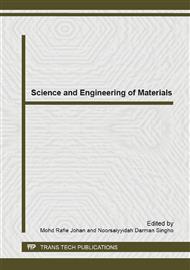[1]
K. Arshaka, K. Twomey, and D. Egan, A Ceramic Thick Film Humidity Sensor Based on MnZn Ferrite, Sensors, vol. 2, no. 2, (2002), p.50–61.
DOI: 10.3390/s20200050
Google Scholar
[2]
K. Arshak and K. Twomey, Thin films of In2O3/SiO for humidity sensing applications, Sensors, (2002), p.205–218.
DOI: 10.3390/s20600205
Google Scholar
[3]
J. S. Atchison and C. L. Schauer, Fabrication and characterization of electrospun semiconductor nanoparticle-polyelectrolyte ultra-fine fiber composites for sensing applications., Sensors (Basel, Switzerland), vol. 11, no. 11, (2011), p.10372–87.
DOI: 10.3390/s111110372
Google Scholar
[4]
L. Schmidt-Mende and J. MacManus-Driscoll, ZnO–nanostructures, defects, and devices, Materials Today, vol. 10, no. 5, (2007), p.40–48.
DOI: 10.1016/s1369-7021(07)70078-0
Google Scholar
[5]
M. Awalludin, M. H. Mamat, M. Z. Sahdan, Z. Mohamad, and M. Mohammad Rusop, Nanostructured Zinc Oxide Thin Film Based Humidity Sensor Prepared by Sol-Gel Immersion Technique, Advanced Materials Research, vol. 667, (2013), p.553–557.
DOI: 10.4028/www.scientific.net/amr.667.553
Google Scholar
[6]
P. K. Kannan, R. Saraswathi, and J. B. B. Rayappan, A highly sensitive humidity sensor based on DC reactive magnetron sputtered zinc oxide thin film, Sensors and Actuators A: Physical, vol. 164, no. 1–2, (2010), p.8–14.
DOI: 10.1016/j.sna.2010.09.006
Google Scholar
[7]
P. Biswas, S. Kundu, P. Banerji, and S. Bhunia, Super rapid response of humidity sensor based on MOCVD grown ZnO nanotips array, Sensors & Actuators B: Chemical, vol. 178, (2013), pp.331-338.
DOI: 10.1016/j.snb.2012.12.116
Google Scholar
[8]
J. -W. Hoon, K. -Y. Chan, J. Krishnasamy, T. -Y. Tou, and D. Knipp, Direct current magnetron sputter-deposited ZnO thin films, Applied Surface Science, vol. 257, no. 7, (2011), p.2508–2515.
DOI: 10.1016/j.apsusc.2010.10.012
Google Scholar
[9]
B. C. Yadav, R. Srivastava, and C. D. Dwivedi, Synthesis and characterization of ZnO–TiO2 nanocomposite and its application as a humidity sensor, Philosophical Magazine, vol. 88, no. 7, (2008), p.1113–1124.
DOI: 10.1080/14786430802064642
Google Scholar
[10]
K. Chou, T. Lee, and F. Liu, Sensing mechanism of a porous ceramic as humidity sensor, Sensors and Actuators B: Chemical, vol. 56, no. 1–2, (1999), p.106–111.
DOI: 10.1016/s0925-4005(99)00187-2
Google Scholar


